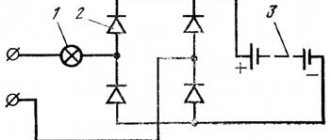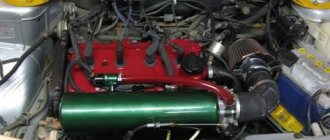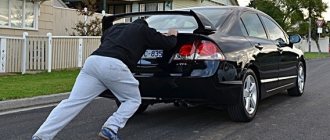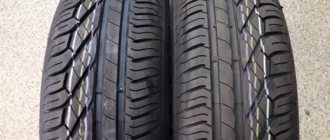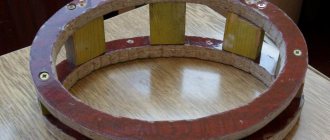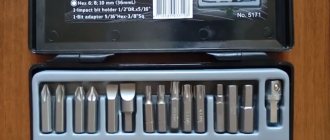How to back up correctly
In this article, we will try to understand what it means to reverse correctly, evaluate the true risks of this type of movement, consider the two main methods that most drivers use, study the rules governing such driving, and, of course, try to learn how to drive safely!
We will tell you how to do it in order to reduce the risks during such a maneuver to a minimum.
Driving in reverse - what not to do
The difficulty of this element of movement is that most often you have to go back not along a straight path, but with several turns. At this moment, it’s as if you are transferring to a different car, which has a completely different arrangement of drive and steering wheels, but most importantly, the visibility has been significantly changed.
Among Ukrainian drivers, two methods of driving backwards are usually practiced: placing your right hand behind the back of the front passenger seat and turning as far back as possible, looking through the rear window; Reverse control using side mirrors.
But according to emergency driving experts, none of these methods give the driver sufficient control over the situation. For example, during test runs using the first method, such movement turns out to be quite slow, chaotic and jerky, because the driver in such a situation can only steer with one hand.
Never forget one of the most important rules of a driver: both hands must be on the steering wheel. This also applies to reversing.
In addition, the driver’s visibility from the rear and front is significantly narrowed - and you can easily not even see the car. And by completely concentrating on looking back, you cease to control the situation in front of the car, whose nose begins to drift significantly when turning.
In real life, all this means getting into an accident. The second method is better because the driver steers with both hands. This type of reverse driving is faster and better controlled.
What are we risking?
It would seem, what serious thing can happen when a car is moving in reverse, if at the same time you carefully look around and observe pedestrians, standing and passing vehicles? But in fact, while driving, twisting his head back in an unnatural way, and having several meters of the length of the car behind him, the driver is in a vulnerable position, losing large chunks of space in his view.
In addition, a person is physiologically not able to move backwards at all. What can we say about the situation when he also has to drive a car that has its own dimensions, inertia and mechanical limitations.
How to drive a car with a manual transmission?
Most of the driving schools today have a brand new fleet of vehicles with automatic machines. Therefore, minimal time is devoted to learning to drive cars with a manual transmission. As a result, the risk of accidents increases.
A car enthusiast can obtain some useful knowledge from the Internet. Our material will be no exception. But let's start from the very beginning.
Preparing for the start. Before starting a car, the driver must take care of his own comfort. You need to adjust the seat and check the condition of the side mirrors. Don't forget about seat belts.
Pulling away without gas. If the road is straight and the car is in good condition, then it will go without pressing the gas pedal: just the clutch is enough. Moreover, at the stage of learning to drive, this method gives the driver more skills.
The algorithm consists of the following sequence: pressing the clutch all the way - engaging first or reverse gear (depending on the direction of movement) - gradually releasing the pedal.
As soon as the car starts moving, the pedal is fixed until a constant speed is reached. It is held until the car reaches a constant speed. Then the clutch is released and the gas is applied.
However, it is better to use the gas pedal for the following reasons:
- there is less chance that the engine will stall;
- the gas pedal is simply necessary in unfavorable road conditions;
- When driving through mud, snow and puddles, you simply cannot do without gas.
Start with gas. Initially, it is better for a beginner to get used to the accelerator and, as they say, get a feel for it. You need to press the pedal and hold it until the engine speed reaches 1500 rpm (this will be visible on the tachometer). It is recommended to do this exercise several times.
The following simplified diagram looks like this:
- the clutch is pressed all the way;
- first or reverse gear is engaged;
- the accelerator pedal is pressed until 1500 rpm and held in this position;
- the clutch is smoothly released before the car begins to move; when a constant speed is reached, the foot is removed from the pedal;
- the accelerator is activated until a speed of 20 km/h is reached.
Acceleration to high speeds is carried out gradually as follows:
Pressing the clutch - releasing the gas - changing to the desired gear (2,3,4,5) - releasing the clutch - pressing the gas until the desired speed is reached.
The gear shift margin depending on the speed may differ depending on the car model. But on average it looks like this:
- first - 0-20 km/h;
- second - 20-40 km/h;
- third - 40 - 60 km/h;
- fourth - 60 - 80 km/h;
- fifth from 80 km/h and above.
Of course, you can accelerate to a decent speed in low gears. But you will have to pay for this with increased fuel consumption.
Acceleration and gear shifting skills eventually become automatic. However, the more time the driver spends behind the wheel, the easier it will be for him to navigate the road situation.
- Rain is a joy for us. Test drive of Viatti Bosco H/T V-238 SUV tires
See all photo news >>
How to change gears in a car
- Remove the tunnel lining on the floor of the car.
- Using a 13 mm wrench, unscrew the nut that secures the gear lever shaft.
- Remove the screw securing the axle support, after which the lever is moved to the side and dismantled together with the assembly.
- In front of you are two plastic bushings and one spacer bushing. If these elements malfunction, the parts must be replaced. Please note that plastic bushings are split in design, so do not confuse a cut with damage.
- Install all elements in reverse order. Before installing the bushings, they must be lubricated with Litol.
Please note => When is the refund paid for the kindergarten?
How to learn to drive a manual car
First, it is recommended to lower the windows - this way you will better hear the sound of the engine. Rearview mirrors should be positioned so that they are as comfortable as possible for viewing. Having prepared, you need to buckle up and follow the algorithm below.
The gas pedal is on the right side, the brakes are in the center, and the clutch, respectively, is on the left. Everything is simple here, so let's move on to the next step.
- For those who don’t know, the clutch pedal is designed to change gears. First, you need to make sure that in the future you can press this pedal all the way with your left foot. This is explained by the fact that gear shifting is only possible if the clutch is fully depressed.
- Adjust the seat. If necessary, adjust your seat so that you can easily reach the clutch.
- Practice using the clutch pedal. Next, you need to become familiar with how exactly pressing this pedal differs from similar actions with others. To this end, they need to be pressed one by one for a while in order to get used to the location. In this case, press the clutch only with your left foot, and the brake and gas with your right! Release the clutch slowly several times until your foot gets used to it.
- Engage neutral gear. To do this, you need to select the middle position of the gear shift lever (it should be located in the center). In order to determine whether the neutral position was actually turned on, you just need to pull this lever left and right. If its movement is free, neutral gear is considered engaged.
- Start the engine by first pressing the clutch pedal. Many car models are characterized by the fact that the engine can only be started with the clutch depressed. Moreover, this is also a kind of safety measure - if the lever was accidentally left in some gear, the clutch will prevent the car from unintentionally jerking when starting.
- Engage first gear. The next step is to depress the clutch again and engage first gear. As a rule, it is located in the upper left corner, although it is recommended to clarify its location in advance. Also note that the location of all speeds is usually indicated on the lever handle in the form of a miniature diagram.
- Practice releasing the clutch. You should start by smoothly and slowly releasing the pedal until the engine speed begins to drop. Then the pedal is pressed down again, and the exercise is repeated so much that you can hear by ear the moment when the revolutions begin to drop ( this is also called the “clutch moment”
). - Get moving. To do this, you need to engage first gear, and then smoothly release the clutch - traditionally until the speed drops. At this moment, lightly press the gas with your other foot, while you continue to release the clutch. If this is done too slowly/fast, the car will most likely stall. But there’s nothing wrong with that - repeat the exercise until you learn to move off more or less confidently.
See how to properly start with a manual transmission:
Particular attention should be paid to what is in front of the vehicle. If training is carried out with an assistant, then he should sit on the side and be ready to pull the handbrake if necessary.
This moment is considered one of the most difficult, but with due diligence, sooner or later everything will definitely work out.
- Second gear. After the start, you need to drive in first gear for some time to get used to everything. Then, when the engine speed exceeds 3 thousand, you need to release the gas while simultaneously squeezing the clutch. While the car is coasting, you need to engage second gear and then completely release the clutch. Only after this can you accelerate further. All subsequent gears are engaged in the same way.
- Drive in gear. After engaging the gear, your foot must be removed from the clutch. You should not keep it on the pedal all the time, otherwise the clutch mechanism will fail prematurely.
- Brake. If you need to stop, you need to move your foot off the gas to the brake pedal. Press with the required force. At a speed of 10-15 kilometers, the car will begin to shake a little - at this moment you need to squeeze the clutch and turn on neutral.
When everything starts to work out, you will be surprised to notice that controlling the mechanics is not as difficult as many people think
. Keep learning and improve your skills to make driving even more fun!
Start of movement on mechanics
How to start with a manual transmission correctly
How to start with a manual transmission – Starting to move. Before moving away, carefully, through the glass windows, and not just in the mirrors, you need to look to the sides, forward and backward, in order to avoid an accident with an unnoticed moving or standing obstacle. Then you need to signal with a turn signal that movement is starting. Then you need to depress the clutch pedal all the way, and move the gearbox lever to the 1st gear position; to do this, the lever must be moved to the left and forward. Without removing your feet from the clutch pedal, you should lower the handbrake lever and put your hand on the steering wheel. Very slowly release the clutch pedal, while listening to how the engine works. As soon as you hear that the crankshaft speed begins to decrease, you should hold the pedal a little in this position, simultaneously pressing the gas pedal. The car will start moving, and you need to calmly release the clutch without finishing pressing the gas pedal. How to start with a manual transmission - Mistakes. Many of the beginners do not fully unscrew the clutch pedal, which creates some problems when jerking into 1st gear. Periodically, this process is accompanied by a grinding noise coming from the gearbox. This is very dangerous and may damage it. Incorrectly pressing the gas pedal is also one of the mistakes beginners make. An excessively early increase in the fuel supply leads to the engine roaring, but the car does not move because the clutch has not yet been fully released. An excessively late increase in feed leads to the fact that the car simply stalls, moreover, making a jerk forward. And this can already become a reason for the clutch to become out of working condition. If you release the clutch pedal too quickly after pressing the gas pedal, the car jerks and begins to stall, which will naturally lead to damage to the clutch. Usually, the driver, as a rule, correctly determines the moment when it is necessary to start increasing the fuel supply, but if, instead of releasing the clutch gradually, he quickly releases the pedal, such actions will probably have bad results for the clutch. The next mistake is an excessively sharp increase in the fuel supply. This leads to the fact that the car, instead of moving off smoothly, quickly and periodically with squealing tires, flies away. How to move off manually - Conclusion. The process of starting to move the car, which at first seems very easy, actually leads to some difficulties for many beginners. Almost all beginners learn to drive a car, it jerks and stalls. Although this only applies to those who are learning to drive a manual car. With automatic transmissions this process is much simpler. In this case, in order to get moving, it is enough to simply move the gear shift lever to the driving state, usually this is position D, but not always, and then gradually increase the fuel supply and press the gas pedal.
How to start with a manual transmission?
Now, let's move to the driver's seat and try to move away. But first, make sure that there is enough room in front of you to move and that you are dealing with a manual transmission, because now we will deal with it.
- The starting position is neutral gear and the handbrake is applied.
- Turn the ignition key and start the engine.
- With your right foot on the brake pedal, you press the clutch with your left.
- Next, switch to first gear, release the handbrake and turn off deep analytical processes in the brain. Now you only need your feelings.
- Begin to release the clutch pedal very slowly. Goal: to feel, catch, feel, realize the moment of actuation, grasping of the clutch. This process can be visually controlled using the tachometer; the needle on the display will tremble.
- So, as soon as we caught this moment. move your foot from the brake pedal to the gas pedal and gradually add speed, keeping the clutch at the “grabbing” moment. We gradually add gas until the car starts to move a little, then gradually release the clutch and then add more gas.
If you did everything correctly, then the indescribable joy of movement will fill your entire being. If a mistake was made, then you will feel something like a jerk - when the clutch is sharply released, a “roar” of the engine - with early and strong pressure on the gas pedal, or simply “stall” - if the clutch was released at insufficient engine speed (low pressure on the gas pedal).
Remember, the above method is the classic way to start a car. We advise you to do just that.
Here is a video with a completely different technique for starting a car:
This option is also effective, but it may cause the clutch to burn out. You will feel this by the specific smell inside the car.

